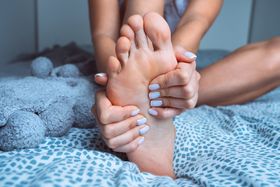Best Home Remedies for Heel Spurs
Updated December 6, 2024

Heel spurs refer to bony protrusions that extend from the calcaneus bone, usually due to a calcium buildup as a response to repetitive stress and strain. The spur may protrude into the soft tissue surrounding the heel, leading to inflammation and pain.
Symptoms of a heel spur include sharp stabbing pains in the morning, with duller aches later in the day. There can be point tenderness to the touch in the middle of the affected heel and a feeling of warmth around this area.
What Causes Heel Spurs?
Repeated micro-tearing of the membrane covering the calcaneus and aggravation of the area due to increased tension of the plantar fascia from plantar fasciitis, are further causes of heel spurs. Moreover, they can also occur due to the influence of systemic conditions, such as rheumatoid arthritis and gout. Those with excessive heel strike in the gait cycle, and those regularly doing high-impact exercise, can develop this foot condition. A person's weight and sex can also contribute to a greater likelihood of a buildup of calcium deposits - with more women and overweight people suffering from heel spurs.
Natural Treatments for Heel Spurs
There are many natural remedies to help you manage your heel pain at home, without more extreme treatment methods like surgery. Although natural remedies won’t cure the bony spur, they do slow the growth of the spur and decrease the severity of pain.
To start, you can aim to relieve the pressure on the heel by taking a look at the shoes you wear regularly, and determining whether they are suitable for your condition. Shoes with hard soles may aggravate symptoms, especially during day-to-day activities. When it comes to shoes for exercise activities, look for shoes with a shock-absorbent sole to reduce some of the force during heel strike.
Custom-made orthotics and shoes may be a relatively inexpensive way to manage the heel pain associated with the continued pressure on the heel. Orthotics distribute weight evenly throughout the foot and thus take the strain off the structures in the heel. This will slow the development of a heel spur.
Massage Techniques for Heel Spurs
Massage is a great way to treat symptoms associated with heel spurs. The areas to massage include the sole of the foot, areas around the heel, and the calf muscle. Massage promotes the lengthening of structures to reduce tension, as well as increasing circulation, which promotes healing. Massaging the underside of your foot with a massage ball can relieve tension in the plantar fascia that could be contributing to the development of a heel spur. A foam roller can also be used to massage and stretch the structures that may be contributing to your daily symptoms.
Self-massage can be done in the comfort of your home. Starting at the heel, take your thumb and gently apply circular massaging strokes to the area. The amount of pressure you use should not cause any pain. You can apply circular strokes to the sole of the foot towards the toes, and thereafter, long strokes across the length of the foot.
Exercises for Heel Spurs
Exercise to strengthen and promote mobility in the joints of the ankle, knee, and hip will also aid you in relieving your symptoms. Below are some of the best exercises to do.
- Calf muscle stretch against a wall: This stretch can be done against the wall, which provides a stable base to stretch against. Stand upright and place your forefoot with the toes facing forward against the wall. Slowly bend the knee to feel the stretch in the calf muscle.
- Calf stretch using a towel: Start by sitting with your legs out in front of you. Put a towel around the forefoot of one of your feet, and pull your toes toward you, stretching the calf muscle. Hold for 15-20 seconds.
- Calf isometric exercises with a towel: Start in the same position as before, with the towel around your forefoot. Push your forefoot into the towel and apply equal resistance by pulling back with your arms. Hold for five seconds and repeat 10-15 times per leg.
- Toe exercises: Place the feet flat on the floor with the weight distributed evenly across the foot. Lift the toes of one foot off the ground and hold for 2-3 seconds, and repeat ten times. Lift the toes off the floor while fanning them out from one another. Hold and then repeat.
- Yoga: Yoga has been found to be very effective in reducing pain in the body, including the foot and heel.
There are many ways to treat foot conditions, including heel spurs. These bony protrusions can easily and simply be treated at home with natural remedies, massage, and exercise. Keep in mind, however, that if your symptoms persist or worsen, you should receive professional medical advice from a healthcare professional.








